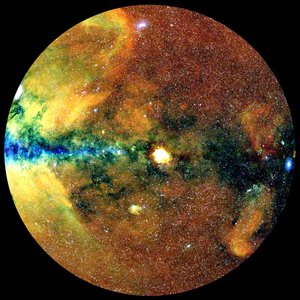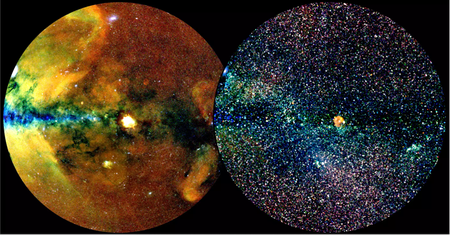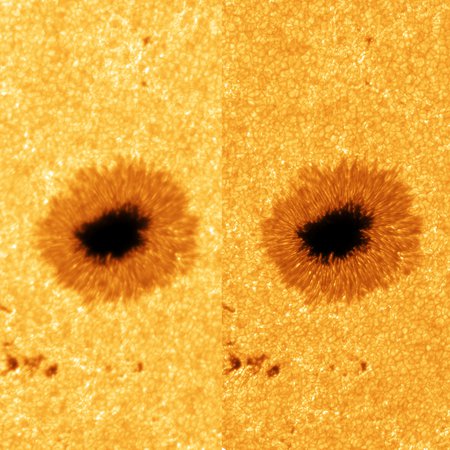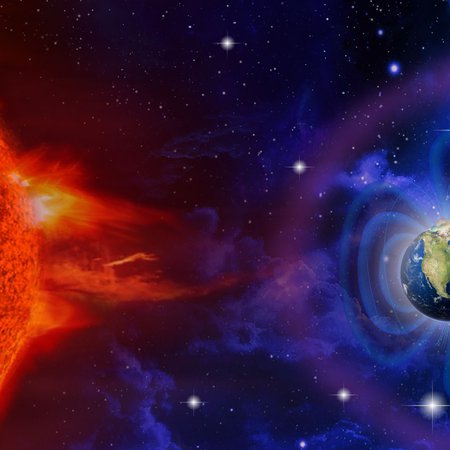First eROSITA sky-survey data release presents the largest ever catalogue of cosmis X-ray sources
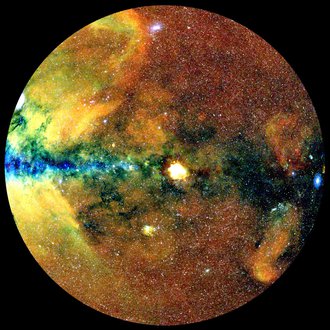
The X-ray sky, projected onto a circle (so-called zenith equal area projection) with the center of the Milky Way on the left and the galactic plane in the horizontal. The photons are color-coded according to their energy (red for energies of 0.3-0.6 keV, green for 0.6-1 keV, blue for 1-2.3 keV).
Credit: MPE, J. Sanders for the eROSITA consortiumToday, the German eROSITA consortium released the data for its share of the first all-sky survey by the soft X-ray imaging telescope eROSITA flying aboard the Spectrum-RG (SRG) satellite. With about 900 000 distinct sources, the first eROSITA All-Sky Survey (eRASS1) catalogue has yielded the largest X-ray catalogue ever published. Along with the data, the consortium released a series of scientific papers describing new results ranging from studies of the habitability of planets to the discovery of the largest cosmic structures.
Based on just the first six months of observations, eROSITA has already detected more sources than had previously been known in the 60-year history of X-ray astronomy. Now available to the worldwide science community, the data will revolutionise our knowledge of the Universe at high energies.
Just 20 million of the detected X-ray photons come from individually resolved sources. The majority of the measured photons (about 32 %) arise from the so-called "cosmic X-ray background", a steady, X-ray diffuse glow that comes from all directions and is largely produced by the combination of light from distant, unresolved black holes. The second largest component (about 29%) is diffuse emission from the hot gas in the Milky Way, including the famous "eROSITA bubbles". The rest of the photons are produced by interaction with solar wind and by the interaction of cosmic rays with the instrument.
The eRASS1 catalogue covers half the X-ray sky, the data share of the German eROSITA consortium. It consists of more than 900,000 sources, including some 710,000 supermassive black holes in distant galaxies (active galactic nuclei), 180 000 X-ray emitting stars in our own Milky Way, 12,000 clusters of galaxies, plus a small number of other exotic classes of sources like X-ray emitting binary stars, supernova remnants, pulsars, and other objects.
“These are mind-blowing numbers for X-ray astronomy,” says Andrea Merloni, eROSITA principal investigator and first author of the eROSITA catalogue paper. “We’ve detected more sources in 6 months than the big flagship missions XMM-Newton and Chandra have done in nearly 25 years of operation.”
The AIP as one of the core members of the German eROSITA consortium, has provided the software, that detects all the new sources in the just released X-ray catalogue. Software specialist Georg Lamer says “I'm very pleased that the eRASS1 catalogue has already lead to 250 publications from within the eROSITA consortium and I'm looking forward to the world-wide scientific community working on this vast data set”. Along with the catalogue and the software to find new sources the AIP has provided a huge database to determine the maximum X-ray flux of an object not detected in the survey. The database and tool named Upper Limit Server will be of imminent benefit to any scientist among the world-wide astronomical community to find out about X-ray emission from his/her object of interest.
Co-ordinated with the release, the German eROSITA Consortium has submitted almost 50 new scientific publications to peer-reviewed journals, adding to the more than 200 which had already been published by the team before the data release. The new AIP-led scientific publications report the discoveries of an isolated neutron star, rare ultracompact binaries and the complete evaporation of a potential atmosphere on an Earth-like extrasolar planet through X-ray irradiation of the planet host star.
“The quality and amount of the new data, and the breadth of scientific topics that were addressed by the consortium and will be addressed by our colleagues world-wide, is simply overwhelming”, states AIP team lead Axel Schwope. He is participating in the national DFG-funded research network eRO-STEP that is focusing on the study of the endpoints of stellar evolution.
This first eRASS data release (DR1) makes public not only the source catalogue, but images of the X-ray sky at multiple X-ray energies and even lists of the individual photons with their sky positions, energies and precise arrival times. The software needed to analyse the eROSITA data is also included in the release. For many source classes, supplementary data from other wavebands has also been incorporated into so-called “value-added” catalogues that go beyond pure X-ray information.
Further information
eROSITA is the soft X-ray instrument aboard Spektrum-RG (SRG), a joint Russian-German science mission supported by the Russian Space Agency (Roskosmos), in the interests of the Russian Academy of Sciences represented by its Space Research Institute (IKI), and the German Space Agency at DLR (Deutsches Zentrum für Luft- und Raumfahrt). The SRG spacecraft was built by Lavochkin Association (NPOL) and its subcontractors, and is operated by NPOL with support from the Max-Planck Institute for Extraterrestrial Physics (MPE).
The telescope was launched into space onboard the SRG mission on July 13, 2019. Its large collecting area and wide field of view are designed to perform to a deep all-sky survey in the X-ray band. Over the course of six months (December 2019 to June 2020), SRG/eROSITA completed the first survey of the whole sky at energies 0.2-8 keV, which is significantly deeper than the only existing all-sky survey with an X-ray imaging telescope, performed by ROSAT in 1990 at energies 0.1-2.4 keV. Three more scans of the entire sky were completed between June 2020 and February 2022. eROSITA has been placed in Safe Mode in February 2022, and has not restarted science operations since.
The German eROSITA Consortium is led by the Max Planck Institute for Extraterrestrial Physics (MPE), and includes the Dr. Karl Remeis Observatory Bamberg, the University of Hamburg Observatory, the Leibniz Institute for Astrophysics Potsdam (AIP), and the Institute for Astronomy and Astrophysics of the University of Tübingen, with the support of DLR and the Max Planck Society. The Argelander Institute for Astronomy of the University of Bonn and the Ludwig-Maximilians-Universität Munich also participate in the science exploitation of eROSITA as associated institutes.The eROSITA data are processed using the eSASS software system developed by the German eROSITA consortium.
Facts & Figures:
- Observation period: 12 December 2019 – 11 June 2020
- Days of observations: 184
- Observing efficiency (avg. fraction of time spent by the telescope collecting data): 96.5%
- Total number of individual photons detected in the 0.2-2 keV energy range: 170 million [half-sky]
- Total number of detected X-ray sources: ~900k [half-sky]
- Total number of detected AGN (accreting supermassive black holes): ~710k [half-sky]
- Total number of detected stars in the Milky Way: ~180k [half-sky]
- Total number of detected clusters of galaxies: ~12k [half-sky]
- Total volume of scientific data transmitted down to earth by the instrument: 75 GB [all-sky]
- German eROSITA Consortium: ~250 members (incl. 80 early career researchers)
Press release of the MPE: https://www.mpe.mpg.de/7991617/news20240131
Press kit of the MPE (images and videos): https://www.mpe.mpg.de/7991089/erass1-presskit
Scientific article for the catalogue:
Merloni et al.: The SRG/eROSITA all-sky survey, First X-ray catalogues and data release of the Western Galactic hemisphere, A&A volume 682, A34.
DOI: https://doi.org/10.1051/0004-6361/202347165, https://www.aanda.org/10.1051/0004-6361/202347165
Images
The X-ray sky, projected onto a circle (so-called zenith equal area projection) with the center of the Milky Way on the left and the galactic plane in the horizontal. The photons are color-coded according to their energy (red for energies of 0.3-0.6 keV, green for 0.6-1 keV, blue for 1-2.3 keV).
Big screen size [1000 x 1000, 290 KB]
Original size [1400 x 1400, 510 KB]
The eROSITA X-ray sky with extended sources (left) and the detected individual point sources (right). © MPE, J. Sanders für das eROSITA-Konsortium
